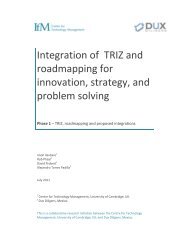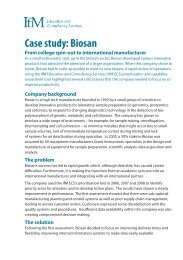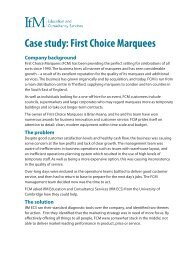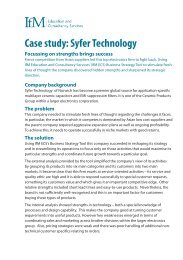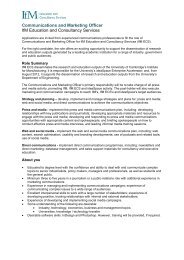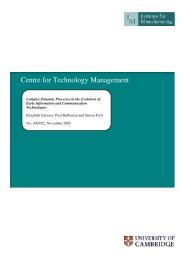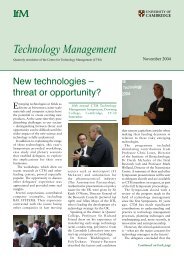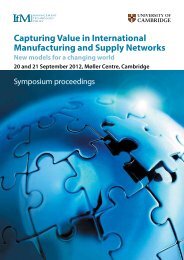The present and future sustainability of clothing and textiles in the ...
The present and future sustainability of clothing and textiles in the ...
The present and future sustainability of clothing and textiles in the ...
Create successful ePaper yourself
Turn your PDF publications into a flip-book with our unique Google optimized e-Paper software.
Major environmental impacts<br />
are related to energy use<br />
<strong>and</strong> use <strong>of</strong> toxic chemicals<br />
Companies face three forms <strong>of</strong> pressure from <strong>the</strong>ir<br />
consumers: shareholder expectations, customer loyalty<br />
<strong>and</strong> ethical pressure. <strong>The</strong>re is considerable evidence<br />
<strong>in</strong> <strong>the</strong> UK that consumer <strong>in</strong>terest <strong>in</strong> ‘ethics’ is grow<strong>in</strong>g<br />
– <strong>and</strong> so bus<strong>in</strong>ess <strong>in</strong>terest <strong>in</strong> develop<strong>in</strong>g <strong>and</strong> manag<strong>in</strong>g<br />
‘Corporate Social Responsibility’ is also grow<strong>in</strong>g.<br />
<strong>The</strong> major environmental issues associated with <strong>the</strong><br />
sector are .<br />
• Energy use <strong>in</strong> laundry, production <strong>of</strong> primary<br />
materials especially man-made fibres <strong>and</strong> <strong>in</strong> yarn<br />
manufactur<strong>in</strong>g <strong>of</strong> natural fibres.<br />
• Use <strong>of</strong> toxic chemicals which may harm human<br />
health <strong>and</strong> <strong>the</strong> environment – <strong>in</strong> particular <strong>in</strong><br />
conventional cotton production. A13<br />
• Release <strong>of</strong> chemicals <strong>in</strong> waste water<br />
– especially <strong>in</strong> wet pre-treatment, dye<strong>in</strong>g, f<strong>in</strong>ish<strong>in</strong>g<br />
<strong>and</strong> laundry – which may harm water based life.<br />
• Solid waste aris<strong>in</strong>g from yarn manufactur<strong>in</strong>g <strong>of</strong><br />
natural fibres, mak<strong>in</strong>g up <strong>and</strong> disposal <strong>of</strong> products<br />
at <strong>the</strong> end <strong>of</strong> <strong>the</strong>ir life.<br />
Social implications for <strong>the</strong><br />
<strong>cloth<strong>in</strong>g</strong> <strong>and</strong> <strong>textiles</strong> <strong>in</strong>dustry<br />
In both sectors <strong>the</strong>re are still many concerns about<br />
<strong>the</strong> quality <strong>of</strong> <strong>the</strong> jobs <strong>the</strong>y create <strong>and</strong> <strong>the</strong>ir social<br />
consequences.<br />
<strong>and</strong> <strong>textiles</strong> have a legally def<strong>in</strong>ed m<strong>in</strong>imum<br />
wage, but social campaigners assert that <strong>the</strong>re<br />
is a difference between such a ‘m<strong>in</strong>imum legal<br />
wage’ <strong>and</strong> a ‘m<strong>in</strong>imum liv<strong>in</strong>g wage’ – it may not<br />
be possible to escape from a cycle <strong>of</strong> poverty with<br />
only <strong>the</strong> m<strong>in</strong>imum legal wage.<br />
• Precarious employment: use <strong>of</strong> repeated temporary<br />
contracts or <strong>the</strong> absence <strong>of</strong> any employment<br />
contracts comb<strong>in</strong>ed with delayed payment <strong>and</strong><br />
<strong>the</strong> absence <strong>of</strong> employment benefits, is common<br />
practice <strong>in</strong> some countries.<br />
• Sexual harassment: campaigners for women’s<br />
labour worldwide report cases <strong>in</strong> which women<br />
are threatened by <strong>the</strong>ir superiors <strong>and</strong> unable to<br />
compla<strong>in</strong> A1 , without risk <strong>of</strong> los<strong>in</strong>g <strong>the</strong>ir jobs.<br />
<strong>The</strong> major occupational health issues associated with<br />
<strong>the</strong> sector are exposure to:<br />
• Hazardous chemicals particularly <strong>in</strong> cotton<br />
production, wet pre-treatment, dye<strong>in</strong>g, f<strong>in</strong>ish<strong>in</strong>g<br />
<strong>and</strong> mak<strong>in</strong>g up.<br />
• Fibre dust, especially when process<strong>in</strong>g cotton,<br />
giv<strong>in</strong>g rise to <strong>the</strong> respiratory disease termed<br />
byss<strong>in</strong>osis.<br />
• Noise associated with yarn manufactur<strong>in</strong>g, knitt<strong>in</strong>g<br />
<strong>and</strong> weav<strong>in</strong>g.<br />
• Monotonous repetitive processes <strong>in</strong> mak<strong>in</strong>g up,<br />
lead<strong>in</strong>g to <strong>in</strong>juries amongst sew<strong>in</strong>g mach<strong>in</strong>ists.<br />
• Children: even though <strong>the</strong> elim<strong>in</strong>ation <strong>of</strong> child<br />
labour is one <strong>of</strong> <strong>the</strong> goals <strong>of</strong> <strong>the</strong> International<br />
Labour Organisation (ILO) it rema<strong>in</strong>s a challenge<br />
<strong>in</strong> <strong>the</strong> <strong>cloth<strong>in</strong>g</strong> <strong>and</strong> <strong>textiles</strong> <strong>in</strong>dustry mostly due to<br />
<strong>the</strong> difficulty <strong>of</strong> monitor<strong>in</strong>g subcontractors, <strong>in</strong>direct<br />
workers <strong>and</strong> home workers.<br />
• <strong>The</strong> <strong>in</strong>dustry workforce is largely made up <strong>of</strong> young<br />
women, who are “low skilled” or “unskilled” <strong>and</strong><br />
may be migrants. Such workers are vulnerable to<br />
various forms <strong>of</strong> abuse <strong>and</strong> may not know or be<br />
able to claim <strong>the</strong>ir rights as employees A14 . Some UK<br />
retailers are work<strong>in</strong>g to impose ethical conditions<br />
on <strong>the</strong>ir suppliers <strong>in</strong> an attempt to protect such<br />
workers, but <strong>the</strong> success depends upon rigorous<br />
implementation which is costly. A particular<br />
problem at <strong>present</strong> is that many subcontractors<br />
deny <strong>the</strong> right <strong>of</strong> workers to form an association<br />
(or trade union) to assert <strong>the</strong>ir rights to appropriate<br />
work<strong>in</strong>g conditions, pay <strong>and</strong> tra<strong>in</strong><strong>in</strong>g <strong>and</strong><br />
promotion.<br />
• Pay: most countries supply<strong>in</strong>g <strong>the</strong> UK’s <strong>cloth<strong>in</strong>g</strong><br />
14 WELL DRESSED?





